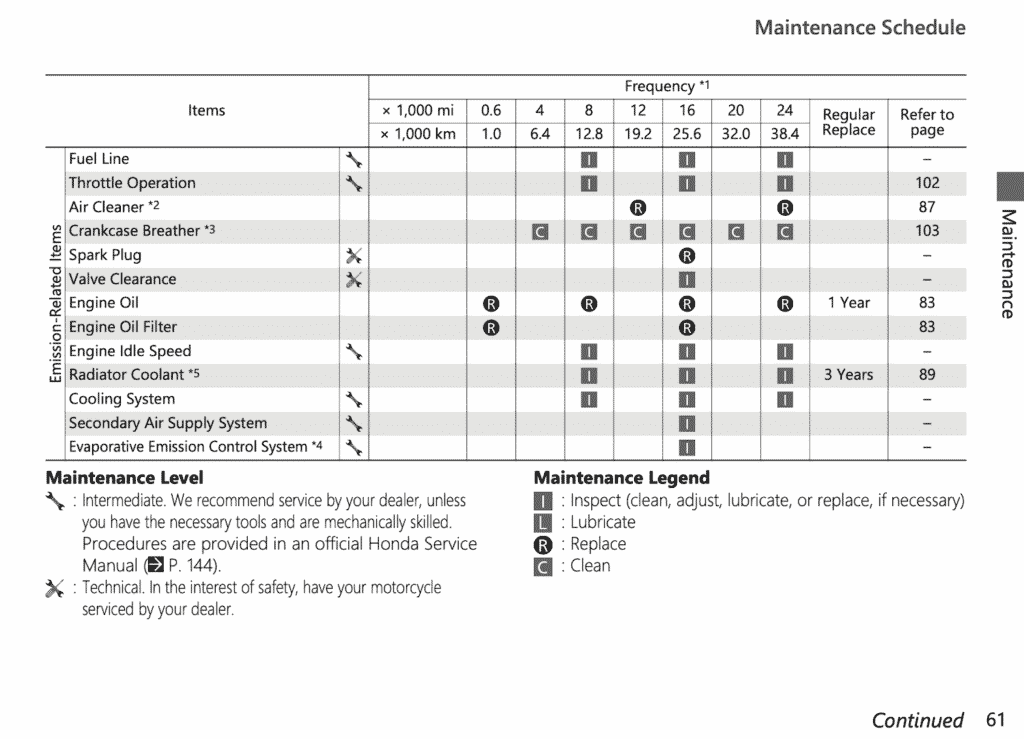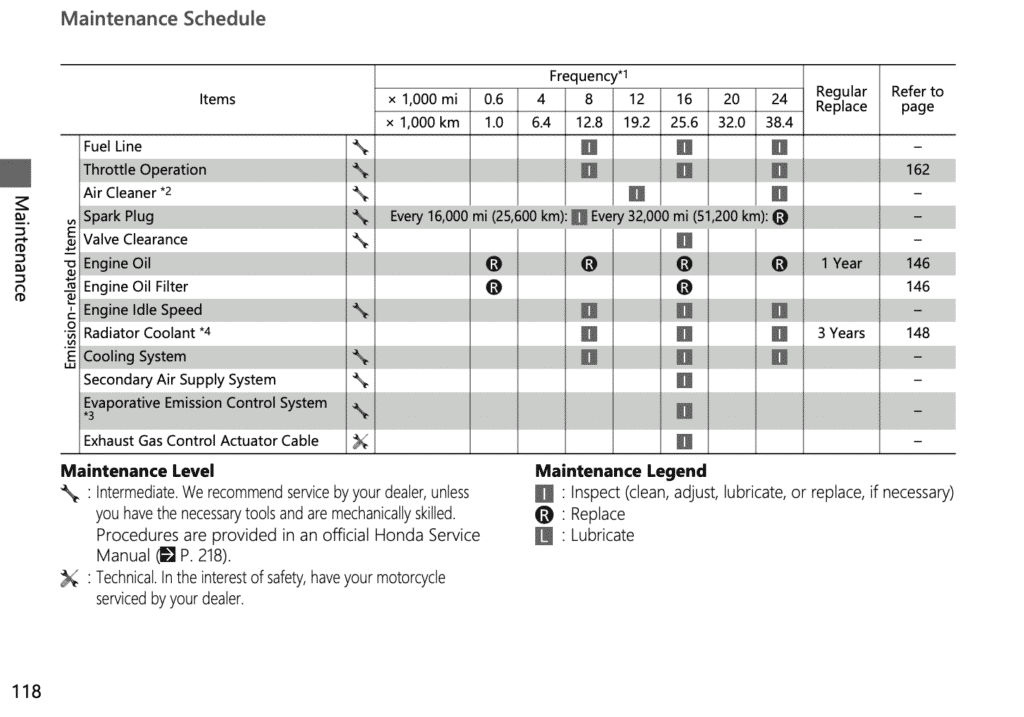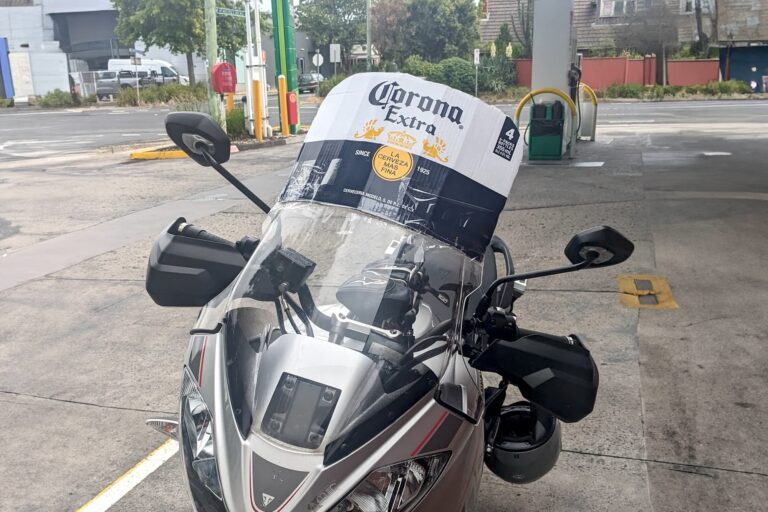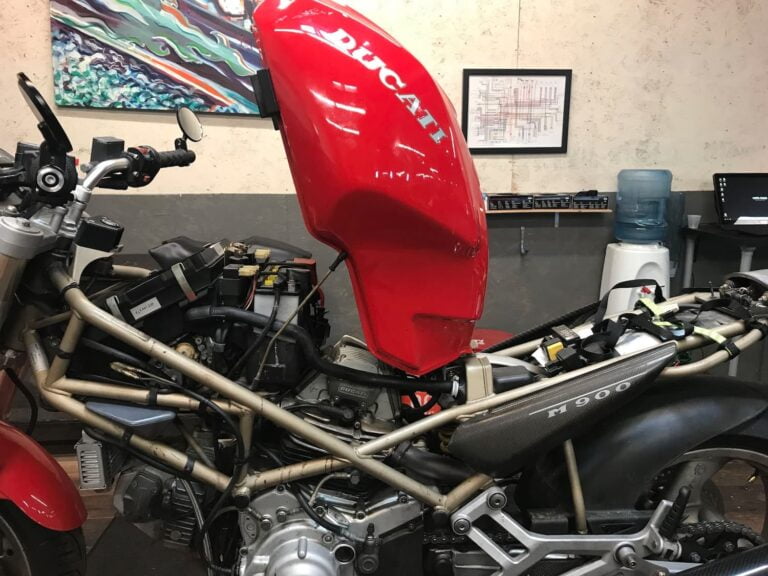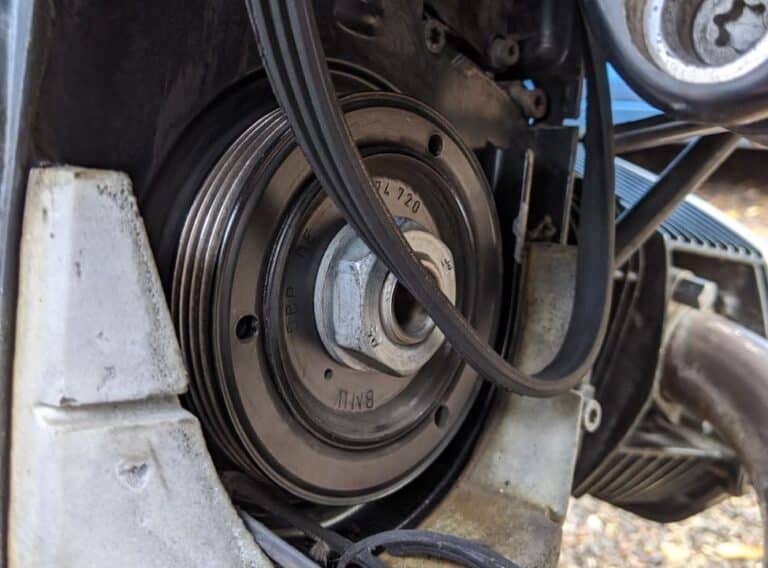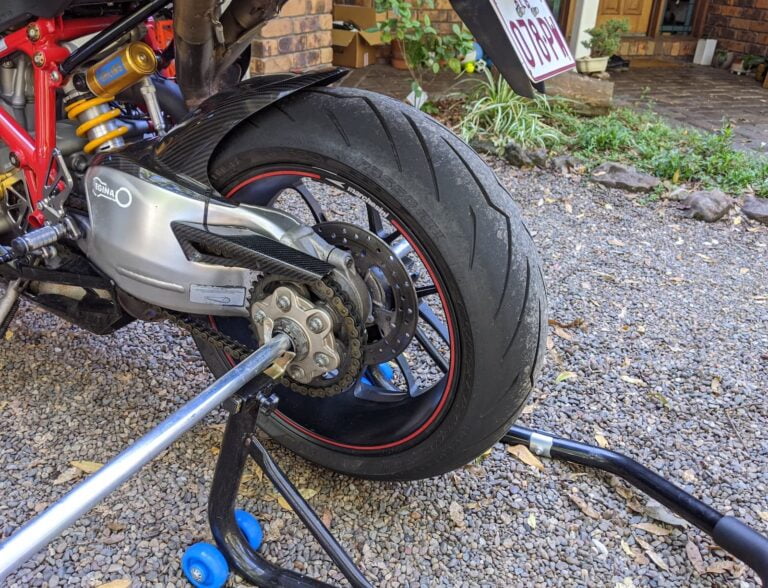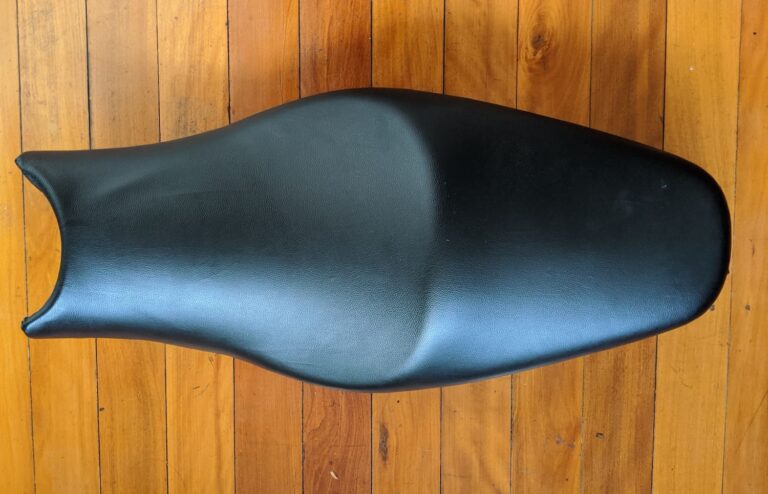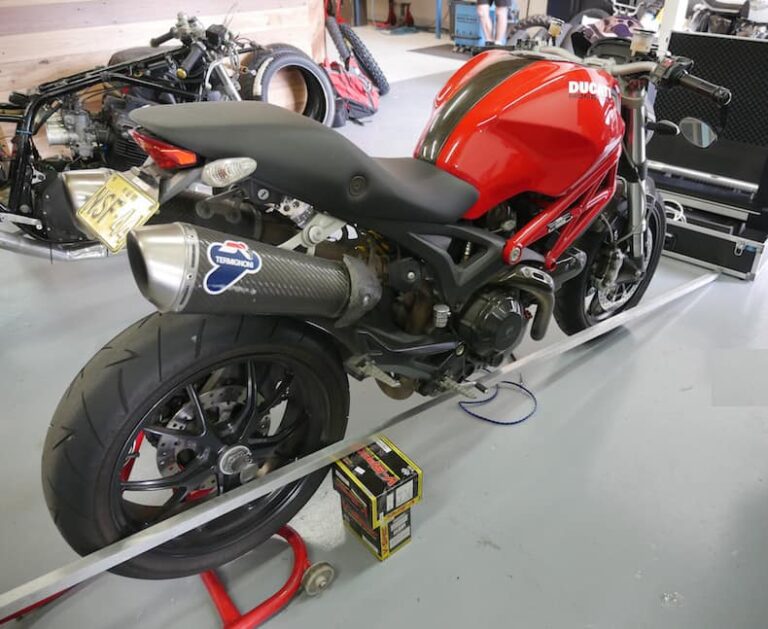One thing I always do when buying a motorcycle (or helping a friend buy one) is to look up the motorcycle maintenance schedule — if I don’t know it off the top of my head already.
Knowing the full maintenance schedule, I can add a bit of spice to the negotiation. Instead of asking “Has it recently been serviced” I can get smart and ask “Has it had its MAJOR service at 26600 miles done?”. If I’m lucky, I get a sheepish shake of the head. (In all honesty I rarely drive a hard bargain. But knowing this stuff also helps show I’m serious.)
But ask any fastidious owner of a bike, and they’ll tell you that they maintain their bikes their own way. They might change the oil really often, always change the filter, and never check the valves because it doesn’t seem to need it.
Then if you consult the manual’s maintenance schedule for a motorcycle, you’ll see line items that you never expected, like to check the “evaporative emissions canister” or to regularly set the idle speed, things that don’t really seem necessary (and definitely not that often). What gives?
So anyway, after reading a lot, practising a lot, and trying to figure out what goes into making a maintenance schedule, I thought I’d share with you my thoughts on what the most important maintenance tasks for motorcycles are.
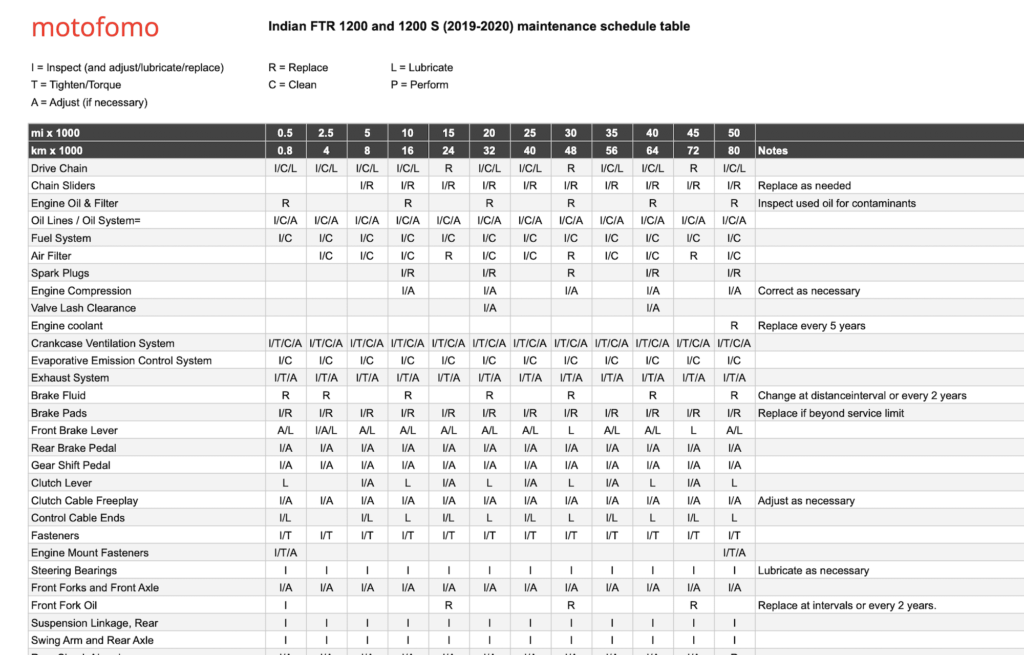
Are you obsessed with motorcycles?
Well, I am. That’s why I created this site — as an outlet. I love learning and sharing what others might find useful. If you like what you read here, and you’re a fraction as obsessed as I am, you might like to know when I’ve published more. (Check the latest for an idea of what you’ll see.)
How to use this advice on Motorcycle Maintenance
As with most readers of this website, I admit that the more I learn, the more I realise have yet to learn. So I may revise this as the years go on, and I welcome feedback and input.
This advice is also for regular use of a motorcycle — for example, as a daily commuter, with fun on weekends and maybe even a couple of track days a year (which may affect your tyre life but won’t destroy your bike).
Obviously, if you are a member of a race team, you’ll follow a much more rigorous schedule, and that’s beyond my ken.
What I hope to point out in this analysis is:
- Things that are less important than you may think (Do you really need to change the oil that often?)
- Things that are more important than you think (It may be time to sync the carbs…)
- Things you didn’t realise you have to do (change some fluids even if you haven’t ridden the bike in ages)
And of course — stuff might happen even if you maintain your bike well.
Things that tend to fail on old bikes even if you maintain them well are:
- Fuel pumps
- Starters, starter relays
- Coolant pumps / radiator
- Bearings (or at least notchiness)
- Suspension components (leaky forks, etc.)
- Cylinder heads
The list goes on. You can’t stop the passage of time.
Where do Motorcycle Maintenance Schedules / Service Intervals Come From?
Ask anyone on a car or motorcycle forum (mental health note: don’t) and you’ll inevitably get two contrasting ideas about service intervals:
- Motorcycle service intervals in manuals are over-conservative because manufacturers have a “cover your ass” policy and/or are in bed with fluids manufacturers (note: they normally do have an agreement with a recommended supplier, e.g. Ducati hearts Shell)
- Motorcycle service intervals in manuals are too wide and a conscientious owner should change the oil and other items much more often just for “peace of mind”.
But there’s surely more to this than speculation. After having pored over literally hundreds of motorcycle manuals, I couldn’t help but ask the question: Where do these motorcycle maintenance schedules come from?
My overall impression is that manufacturers don’t do a lot of model-specific research when making a model’s maintenance schedule.
What I want to believe is that, for example, when Honda releases their latest superbike, they punish 100 engines or thousands of components, using different maintenance regimes, and hone in on the optimal time to do valve services and oil changes to maximise life. But aside from the fact that this sounds very expensive, evidence indicates that they don’t do this.
What seems to be the case is that maintenance schedules are written according to a template for most motorcycles of a general class from one manufacturer (e.g. “Honda modern-ish liquid cooled”), and then modified very slightly — e.g. for a shaft vs. chain drive.
There are a number of clues as to why it seems like manufacturers make maintenance schedules from templates.
In a nutshell:
- The maintenance schedules for many motorcycles within a brand are largely the same.
- The required service intervals of a bike within a brand occasionally changes with no other changes
- The maintenance schedules of very similar motorcycles (e.g. middleweight vs middleweight, or superbike vs superbike) from different brands can differ dramatically.
- Some brands have different maintenance schedules in Europe vs the US, whereas most do not.
More detail on all this below.
Firstly, manuals for most motorcycles from one brand are nearly exactly the same.
I don’t just mean different years of the GSX-R600. Or even the GSX-R600 vs the GSX-R750. I mean that a manufacturer will issue a near-identical service schedule for many different motorcycles.
For example, the valve service interval on nearly every liquid-cooled Yamaha motorcycle from the last 20 years is 26600 miles in US manuals and 40000 km in Europe / APAC manuals. This is for two-, three-, and four-cylinder engines, of many capacities.
Going deeper, the maintenance schedule for the Yamaha MT-07 (a 689 cc parallel twin middleweight) and the Yamaha YZF-R1 (a 4-cylinder superbike) both share nearly every element, including (from the US manual; Europe is slightly different):
- Change oil every 4000 mile / 6000 km or 6 months
- Change spark plugs every 8000 miles / 12000 km or year
- Check valves 26600 mile / 42000 km valve service interval, as mentioned above
You can make similar observations looking at manuals for other brands. Below are screenshots of the maintenance schedules from the 2019 Honda CBR500R (a mildly-tuned commuter sportbike) and the 2019 Honda CBR1000RR (a highly-tuned sportbike that has twice the cylinders and capacity, four times the power, and eight times the “Zounds!” factor).
These come from the 2019 manuals for each courtesy of Honda’s website. Spot the differences!
Secondly, sometimes within a brand, the maintenance requirements of a single class of vehicles change suddenly and for no apparent reason.
This happens rarely, but it has happened.
In the 2000s, everyone knew that the service interval for most Ducati motorcycles was 6000 miles / 10000 km. Suddenly, in the middle of the decade (between 2006-2007 for at least the models I’ve seen), it changed to 7500 miles / 12000 km. No engine technology suddenly changed in that period.
Thirdly, the service interval for ostensibly very similar bikes from different brands — say, two parallel twin middleweights like the Kawasaki Ninja 650 and Yamaha MT-07 — is different.
Yes, these bikes and engines are from different brands. But they’re built to similar budgets and make very similar power and torque. Yet the oil change intervals and the valve service intervals are very different.
Sure, they’re different engines from different makes… but how different could the service requirements of these bikes possibly be?
Finally, most oddly to me, sometimes the maintenance intervals for the same motorcycle (or car) varies by region — mostly between Europe / APAC and the US.
Yamaha is one to do this; for many bikes they recommend six-month or 4000-mile service intervals in the US, and 12 month or 10000 km (about 6000 mile) service intervals in Europe / APAC. Why? I’d love to know.
For most other brands of motorcycle it’s the same regionally. But for globally distributed cars, I’ve also noticed significant differences.
So the reality is that motorcycle maintenance schedules for a manufacturer are mostly built off a template. They take a standard schedule and make modifications based on the individual bike: whether it’s liquid- or air-cooled, chain-, shaft-, or belt-driven, and a few other things. That’s it.
The Impact on Maintenance of Safety and Emissions Regulations
One thing that definitely impacts motorcycle maintenance requirements is emissions and safety regulations. Mostly, these add line items to the maintenance schedule. And in many cases, the schedule’s order is altered.
A long time ago, the first line item in every maintenance schedule was “Change the motor oil”. But for decades, many brands have first mentioned things that are related to emissions.
In every modern motorcycle maintenance schedule, you’ll see a number of items that you may not recognise but that that need service. These include
- Evaporative emissions control device a.k.a. a carbon canister
- Crankcase breather hoses (not every jurisdiction)
- Secondary air supply system (a.k.a. the PAIR system)
- Spark arrester (mostly US)
These items exist because of regulations that say you have to have them for a bike to pass emissions tests. The evap device prevents evaporated fuel from blowing off into the atmosphere. The crankcase breather stops engine oil from just being cast off into the air. The secondary air supply system helps burn off unburnt fuel in the exhaust. And the spark arrester, like you do, helps prevent forest fires.
Many owners of motorcycles actually remove these items. Gasp! It depends a little on how you’re going to use your bike. I’d leave an evap canister on an everyday commuter, but not on a track bike or a stripped back cafe racer that just sits around looking pretty.
On top of that, there are some things that manuals require which are related to emissions, but aren’t as explicit as a whole separate unit dedicated to emissions reduction. These are things like
- Checking the idle speed — obviously a too-fast idle will hurt the overall emissions in city driving. But in reality, the idle speed rarely varies on modern fuel-injected bikes.
- Checking the exhaust for leakage. Yes, it may develop leaks, but you don’t need to check it at every service.
- Adjusting fuel injection sync — again, worthwhile doing after a long period of time or after modifications, but doing this at every service is overkill.
- Checking / replacing spark plugs. Many home mechanics owners clean / gap their own plugs. But manuals suggest replacing them these days. The manual sometimes even says that replacing the spark plugs is essential for maintaining emissions levels low.
Thirdly, there are some safety-related things that manuals recommend — but most mechanics wouldn’t necessarily say you have to do with that rigorous a schedule.
These schedules say that every four (usually) years, you have to:
- Replace the brake lines
- Replace fuel lines
- Replace rubber parts of brake master cylinders and calipers
Those rubber parts tend to deteriorate with time, particularly if you for example leave your bike parked out in the hot sun all year around.
But the reality is that most motorcycle owners, especially bike fans reading this website, cover their bikes or park them in a garage, away from the sun. Your rubber parts are likely to last longer than four years.
Finally, there are a number of things which are marked as related to emissions, but which you probably should do anyway. These are things like
- Checking the valves
- Checking the spark plugs while you’re at it
Taking off the fairings / tank (where you need to) every 30-40000 km (~18-25000 miles) and checking everything is reasonable anyway. But many owners don’t do it.
The only caveat to the above items is that mechanics usually tell me that even the above valve service intervals on most motorcycles are too conservative — valves on Japanese motorcycles in particular rarely need adjusting (and even more rarely after the first service), and when they do, an experienced mechanic will usually know because of audible valve chatter.
(Caveat to the caveat: valve clearances have more significant effect on a desmodromic system because there are twice as many valves, and so twice the opportunity for an out of spec valve to cause pressure loss.)
So what’s left? What maintenance do we actually have to do? Let’s have a look.
Motorcycle Maintenance that you Actually Have to Do
I (and many owners) think of motorcycle maintenance in five categories.
- Everyday checks — Chain (if you have one), plus safety / obvious failures
- Minor service — Oil and filter change, greasing, and the safety once-over
- The Major Service — valves, plugs, air filter
- Periodic replacement (fluids, rubber parts)
- Long-term Greasing
Everyday checks
These are things you do to make sure your bike is safe to ride. A lot of these are common sense. Usually what happens is I realise within the first few seconds to a minute of riding if one of them is not right.
Every day — or before every ride — do the following checks / items of service.
| Motorcycle maintenance everyday checks |
|---|
| Check fluid levels — oil, brake, clutch (if hydraulic) |
| Check oil visually system for leaks (i.e. are there drips on the garage floor?) |
| Check cooling system for leaks (ditto, drips) |
| Check that the clutch and brakes work and have the right play, and aren’t leaking |
| Check the condition of the tires (enough tread, no major damage) |
| Check the condition of the wheels |
| Check the sprockets — no rounding / shark toothing |
| Check the suspension — no weeping. (Especially by you, if you discover it to be weeping) |
| If chain: Check the chain tension and lubrication condition (adjust tension / grease it if necessary) If shaft: Check no leaks in final drive |
| Make sure all the lights work, including the rear brake light |
Checking for leaks is important. Leaks happen to the best machines. Even the legendary BMW S 1000 RR and R 1250 GS’ Hayes calipers were recalled and replaced with Nissin units.
Minor service (the Oil Change)
Usually, people do a minor service anywhere between 3000-8000 miles / 5000-12000 km OR six-12 months.
Yes, those are both big ranges. It partly depends depends on how much you ride and the conditions you store your motorcycle and ride in.
The only major downside to too many oil changes is expense and oil waste, as you can’t just throw it in the trash.
Pro tip — You can dispose of your oil more properly by taking it to any mechanic’s workshop. In principle they may charge you a little fee, but I’ve never seen them do this.
But how often should you actually change the oil? This is where you get paradoxical opinions from owners.
Whereas some motorcycle owners on forums think most items on a maintenance schedule are too conservative, some owners say they like to change the oil more often. As to why, other than love for their precious machines and confirmation bias (“I do it, and it still works!”), I don’t know.
(I do think it has something to do with thinking of our machines as living beings, and wanting to give them clean, fresh blood to run in their veins…)
But I think it’s easier to be consistent and assume the motorcycle manufacturers are conservative with everything on the schedule — including oil change intervals. So I don’t see a reason to do it even more frequently (unless I’m tracking the bike of course).
Your minor service is to do everything in the daily checks above, but to also do the things in the following list.
| Minor service |
|---|
| Clean the bike, run it until its warm and check it for leaks |
| Change the oil |
| Change the oil filter (some do this every 2 services) |
| Check the air filter, clean or replace if necessary (e.g. if you’ve ridden a lot in dust/rain) |
| Grease major external parts — side stand, center stand |
| Lubricate controls (levers and pedals) and cables |
| Adjust the play in the brake and clutch levers |
| Check the bearings for notchiness / play |
| Check the brake pads |
| Check the safety equipment does what it should – brake lever / pedal activates brake light – flasher does flash the high beam – kickstand kills the engine (unless you’ve bypassed it and know what you’re doing!) |
| If chain: Check the chain condition, and replace if necessary If belt: Check the belt condition / tension |
As part of a minor service, you don’t necessarily have to change the brake fluid and the coolant — unless the time has come for those (see below).
Major service
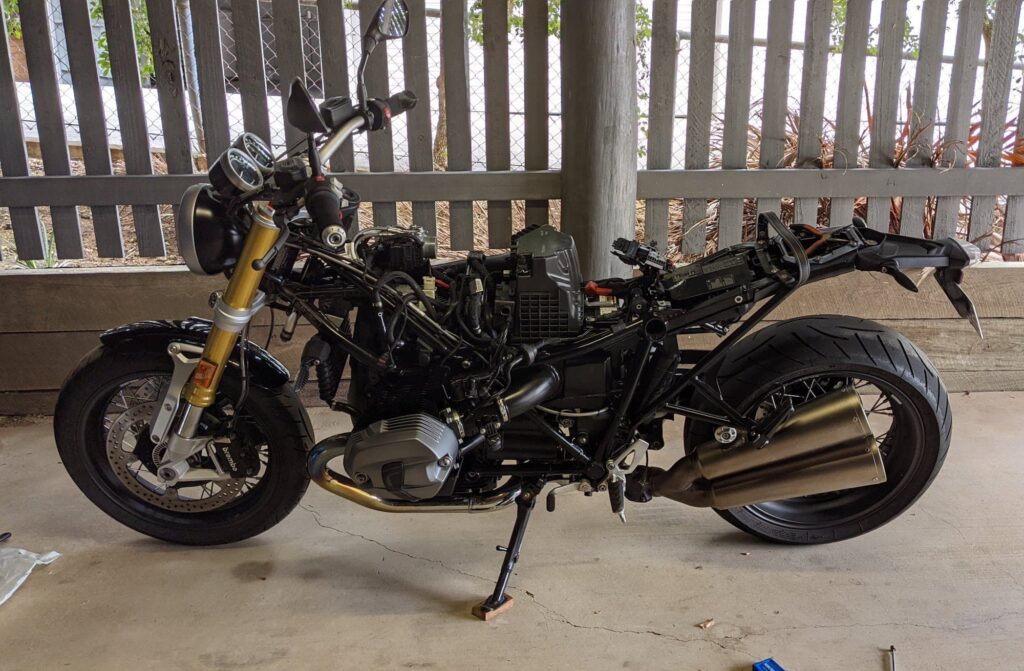
Ah, the major service. The hair on the back of your neck stands up and a cold wind sweeps across the dark tundra. Which will it be this time? A thousand dollars, or a weekend in the workshop, give or take from either?
For the major service, do the items in the minor service and every day checks, and also the below.
| Major service items |
|---|
| Check valve clearances and adjust if necessary |
| Sync carbs / throttle bodies if needed (some bikes have them on cable and far apart) |
| Check spark plug condition. Replace if necessary (modern manuals don’t recommend cleaning and gapping, for emissions reasons) |
| Replace the air filter (unless you did so recently) |
The valve service is the big one. How easy it is to get to the cylinder heads and valves, how often adjustments are needed, and how easy/hard it is to make the adjustments, dictate how annoying this task is.
For example, on an old air-cooled desmodromic V-twin, you have to crack the heads every 6000 miles / 10000 km. Then the rear head is a #*$( to get to, and it’s a shim-and-bucket type, so it’s an exercise in frustration, and if I wanted to do that kind of exercise I’d go back to CrossFit.
On the other hand, if you have a modern liquid-cooled thumper, then you’ll rarely have to adjust it, and it’s easy to do so.
Because the fairings and tank are off to get to the engine (well, unless you have that dirt bike… or a Honda Grom, or a transversely mounted engine like on my R nineT or Moto Guzzi motorcycles), it’s also a good time to do periodic replacements like of hoses.
Periodic replacement items
Annoyingly, there are some parts of a motorcycle that expire with time more than with usage (hours of operation).
These are mostly fluids and rubber parts. They wear out more quickly if you ride your bike hard or if you live in a harsh climate, e.g. one that’s very hot, and if your bike is parked outside.
| Item to change | Every |
|---|---|
| Brake fluid (and clutch fluid if you have it) | 2 years |
| Coolant (if liquid-cooled) | 2-3 years |
| Brake hoses / fuel lines | 4 years |
| Timing belt (Ducati) | 2-5 years |
| Alternator belt (BMW, Moto Guzzi) | 6 years |
These recommendations come from manuals, and they’re all conservative for everyday use of motorcycles.
Brake fluid lasts for significantly more than two years if you’re just using your bike as a commuter or a weekender. The safe recommendation is to change it when you buy the bike, and every two years. But in reality, many owners who just commute forget to do it for years, and may only change the fluid when they feel it’s getting too mushy.
And coolant in many motorcycles is “super long life” type — typically an OAT coolant, or a HOAT with relatively few inorganic compounds in it. In car engines, such coolants can last for 10 years without nary needing a glance. Suzuki manuals tend to say you can change the coolant every 4 years if you use their super long life coolant.
See our complete guide to coolants, which includes a discussion of OAT, IAT, and HOAT coolants (and lots of other stuff).
On the other hand, changing your brake hoses every four years is very conservative to the average motorcycle nut who keeps their bike under a cover in a garage. Yes, if you leave your UberEATS delivery CB125e outside all the time, change the brake hoses every four years. But otherwise, maybe chill out on that one.
On fork oil — some manuals recommend it, and some don’t. The manuals that do are Ducati and others that make bikes typically used for high performance.
Belts — your timing belt on your Ducati is made of similar stuff (presumably, they feel the same and attach to similar things) to a BMW or Moto Guzzi alternator belt. But the timing belt on your Ducati snapping is more catastrophic. It’ll cause bent valves, which means expensive repairs.
If your alternator belt breaks (if you have one), you may not notice it until either your battery light comes on when it drops below a certain voltage, or your bike fails to start. Hopefully you find out before it’s too late.
Long-Term Maintenance
Finally, many manuals recommend doing these items every 50000 km (30000 miles) or so.
Because this distance is so long, and because bikes often change hands with incomplete service histories, these items often get overlooked. The result is that bearings, suspension components, and the final drive fail more often than they probably need to.
| Long-term greasing / fluid changes |
|---|
| Grease wheel bearings |
| Grease the steering bearings |
| Grease swingarm pivot bearings |
| Change fork oil (see notes) |
| Change final drive fluid (if shaft drive) |
| Change the chain and sprockets (see notes below) |
The forks are one of those fairly unique items in a maintenance schedule in that they wear by distance travelled, not hours of engine usage.
In some manuals, e.g. those of BMW (a model with telescopic forks) or Ducati, I’ve seen recommendations that fork oil be changed — in both cases every 30000 km / 18000 miles. While most manuals don’t specify it, this seems like a reasonable interval.
The chain and sprockets will wear differently depending on the type of bike and how it’s ridden. It’ll get worse if the chain isn’t adjusted and goes out of spec.
In some manuals for street bikes I’ve seen a general recommendation that they be changed every 40000 km. With normal street use, it’s somewhere in this order of magnitude.
What can go wrong anyway?
Even if you maintain your motorcycle well, there are parts that will fail anyway.
Generally on old motorcycles I’ve had (or I’ve heard of) things like the following failing:
- Stator coils might fail — usually taking the regulator/rectifier out with it (look at my electrical system troubleshooting guide)
- Fork seals might leak — This is common, especially if your stanchions pit with rust (which also happens with time).
- Tank might go rusty — Happens with time + humidity, especially if ethanol-blended fuel is left in the tank long-term, which will take out the fuel filter
- The cooling system might fail — usually a bad pump, which can be because of bad coolant (made worse by not changing it often enough, or throwing in the wrong spec coolant)
- Brakes might warp — At some point you’ll have to change your brake discs
And all this is assuming you don’t crash the bike!
I should write a whole other article on things to be prepared to spend $$$ on when buying an old bike. Yes, that increasingly classic Yamaha TRX850 looks tempting, but I have to be prepared to pay the price!


